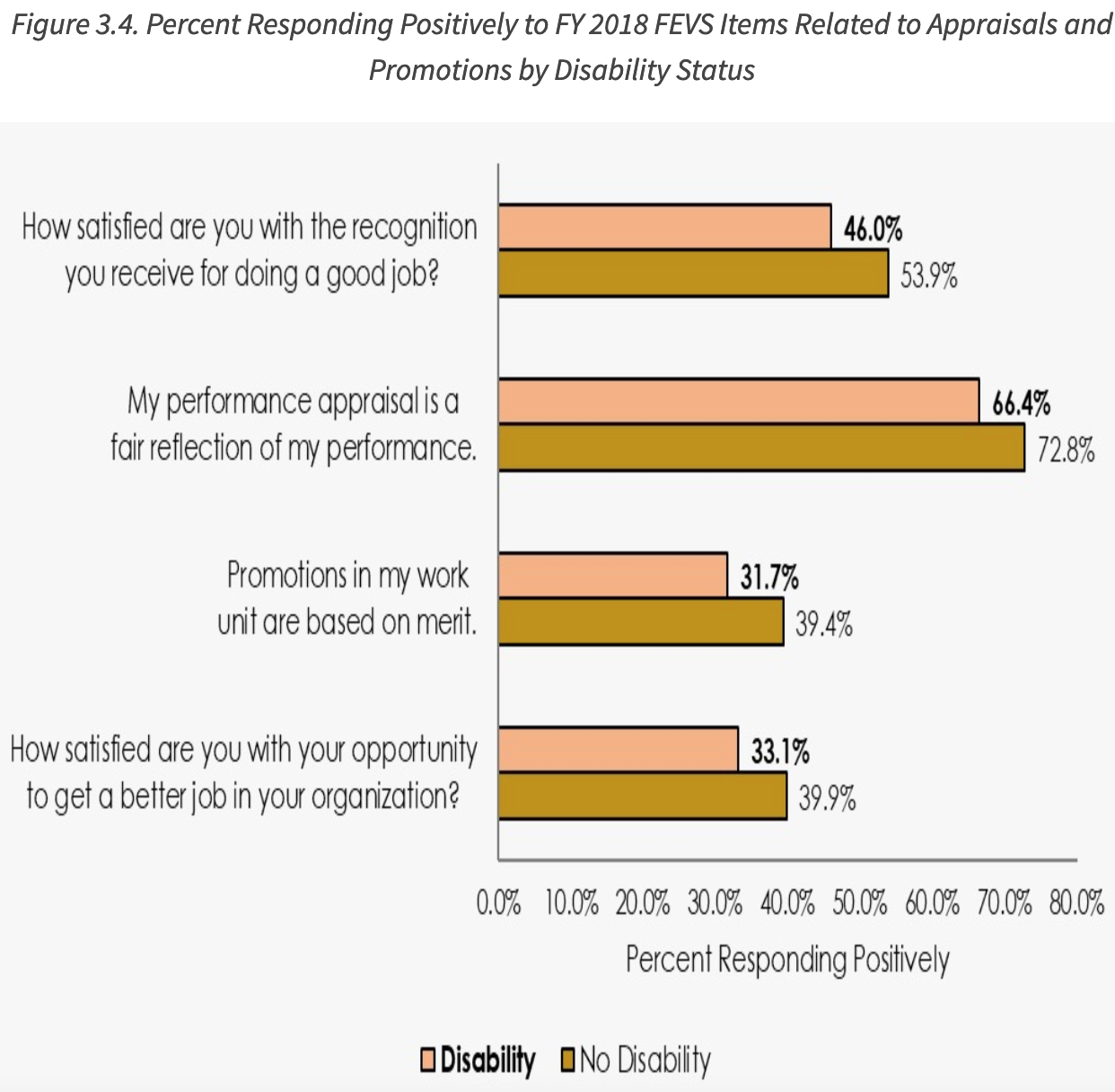
Promotions, mindsets, encouraging environments: 3 workplace improvements for people with disabilities
Problems persist for federal workers with disabilities 32 years after the Americans with Disabilities Act. Here’s what experts say could improve workplace...
For federal agencies to make faster efforts to improve opportunities for people with disabilities, experts say managers need to do three things.
Federal managers across the government need to first encourage a promotion pipeline and then shift mindsets about disabilities. Finally, they need to create encouraging workplaces where people with disabilities feel safe self-identifying.
Almost 32 years after the Americans with Disabilities Act and one year since President Joe Biden’s executive order promoting diversity, equity and inclusion, the overall participation of people with disabilities working within the federal government has increased slightly.
Promotion pipeline
“We don’t have strong numbers in the senior executive service or the upper echelons of the general schedule scale and there continues to need to be real work there to say, you know, ‘If a disabled employee is my best employee, why are they not a manager?’” Rebecca Cokley, disability rights program officer for the Ford Foundation, said at the Partnership for Public Service and the Boston Consulting Group (BCG) event on June 14.

Instead of promotions, the Equal Employment Opportunity Commission found that high percentages of people with disabilities are leaving the public sector involuntarily. On average between 2014 and 2018, people with disabilities were 53% more likely to involuntarily leave the federal government than people without disabilities, according to the 2018 Status of Workers with Disabilities in the Federal Sector.
Actively working to maintain employees with disabilities and to create inclusive environments doesn’t only help workers with disabilities. ADA accessible ramps have proven to be useful for parents with strollers, workers who bike to work and many more people.
“In reality, it is the same thing that we know is important for all employees. It’s good managers that know how to meet the needs of their staff and drive them to perform. It is access to support and services that they need to thrive in the workplace,” Cokley said during the event.
Hillary Wool, principal and disability network lead at BCG, found that mentoring programs, pairing senior staff members with disabilities mentor with junior workers, helped to ensure the retention promotion pipeline at the company.
Shifting mindset and opening discussions
Among other recommendations, experts say how workplace improvements can stem from managers shifting their mindset from the budgetary concerns surrounding disability assistance to the increased productivity workers can provide when equipped with the proper tools.
“Many people within employment spaces still perceive accommodations as charity, not as something that they are legally required to do, and also not as something that is a tool that will ultimately impact the effectiveness and the success of your team,” Cokley said.
The effectiveness of tools can change over time and Cokley says managers are continually working with human resources departments to evolve accommodations as needed. How managers create a culture of acceptance can also change who chooses to identify as having a disability.
In 2018, 9.42% of the 2.7 million federal employees, 259,164 workers, reported having a disability, although more workers could have not reported disabilities due to a lack of understanding or for fear or stigma.
Experts recommend federal agencies maintain an open culture for dialogue about improving accommodations and actively providing resources like movie captions, alternative text for pictures during presentations and creating accessible physical space.
During the event, experts emphasized the importance of shifting the burden of educating non-disabled people about the disabilities will create a more inclusive environment.
“It really is human resources’ job, but yet it always falls to the person with a disability because you’re like, ‘if I don’t do this, my work is going to be impacted, how I’m perceived on my team is going to be impacted,’” Cokley said.
“Even after creating safe environments, not everybody is ready to accept or identify that they have a disability,” Joshua Josa, USAID inclusive education specialist, said. “Although, seeing more managers with disabilities could help create more inclusive, safer workplaces to come forward.”
“We know that there are managers with disabilities, we know their assistant secretaries with disabilities, we know there are cabinet secretaries with disabilities, you cannot expect your staff to self identify if you refuse to one of the number one things that we know leads to successful self self disclosure, is seeing your experience reflected in leadership,” Cokley said.
Hiring practices
In order to continue growing the participation of people with disabilities within the federal workforce, Cokley said placing increased emphasis on the Department of Labor and the Department of Defense’s Workforce Recruitment Program.
The WRP is a recruitment and referral program connecting employers within both sectors to college students and recent graduates with disabilities. The program partners with over 400 universities to place students and recent graduates in summer internships and permanent jobs.
The two agencies created the Workplace Recruitment Program in 1995 and is recognized by the Office of Personnel Management as a model strategy for federal agencies for recruiting and hiring people with disabilities and the pipeline it has built for going into the civilian workforce.
Why now?
Wool says the federal government is at a critical inflection point to implement changes for improving workplace inclusion as government workers are going back into the office.
“In the past year, the labor participation rate of people with disabilities, which has been notoriously very low, has increased by about three percentage points, versus a little bit under 1% for non-disabled individuals. COVID driven workplace flexibility [is] a huge driver there, but we risk moving backwards if organizations aren’t really thoughtful about their back to work policies through an accessibility lens,” Wool said.
Wool’s sentiment echoed Biden’s EO, which said now is the time to “develop a Federal workforce that looks like America where qualified people from every background and walk of life have an equal opportunity to serve our nation.”
Copyright © 2025 Federal News Network. All rights reserved. This website is not intended for users located within the European Economic Area.
Abigail Russ is an intern with Federal News Network.
Related Stories





